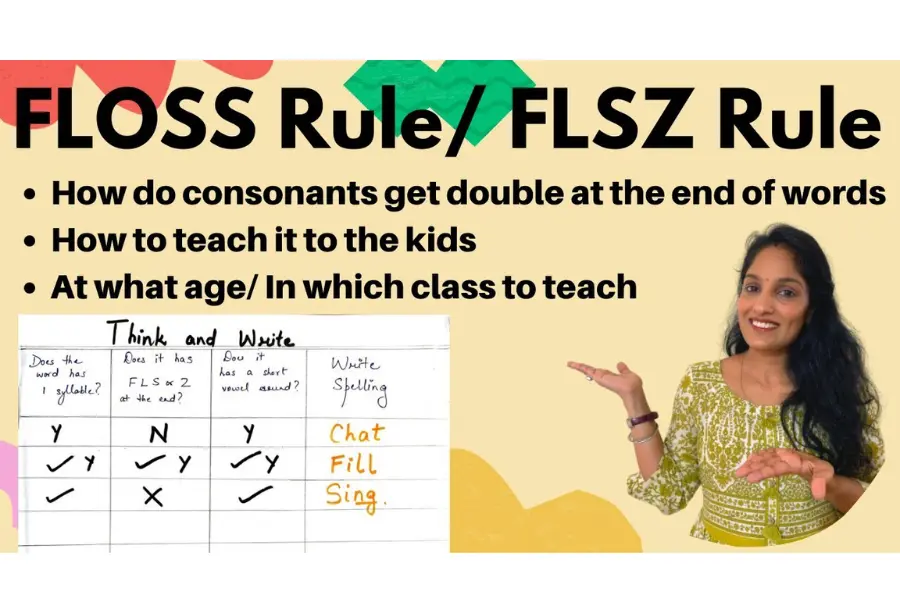
Source: youtube
The Floss Rule in Phonics is a simple, straightforward guide that elucidates why certain words end with a double consonant (like ‘miss,’ ‘buzz,’ etc.) while others (such as ‘rob,’ ‘hot,’ etc.) do not. With this rule, it becomes easier to comprehend when the last consonants ‘f,’ ‘l,’ or ‘s’ are doubled. Familiarizing with this rule helps enhance spelling skills, making it more easier for students to identify spelling structures and avoid common errors.
In this post, we’ll explore how to apply this Floss Rule in Phonics and learn engaging Floss Rule Activities to support learning.
What is the Floss Rule?
The Floss Rule in Phonics describes why few one-syllable words with short vowel sounds end with a double consonant. Mostly, when a word has a short vowel sound and ends in ‘f,’ ‘l,’ ‘s,’ or sometimes ‘z,’ the last consonant is doubled. This is an elementary spelling rule with which students get the clarity of when to add an extra consonant at the end of a word.
For example:
- puff (short vowel sound, double ‘f’)
- tell (short vowel sound, double ‘l’)
- buzz (short vowel sound, double ‘z’)
However, this Floss Rule in Phonics applies only to specific consonants after a short vowel. If the final consonant is not ‘f,’ ‘l,’ ‘s,’ or ‘z,’ it usually isn’t doubled, like in the words ‘rob,’ ‘cat,’ ‘pin,’ etc.
Floss Rule Anchor Chart
A Floss Rule Anchor Chart is a great tool to reinforce the Floss Rule in Phonics visually. It can serve as a daily reminder for students practicing their spelling.
Here’s how you can design a practical Floss Rule Anchor Chart for your classroom:
Simple Description
Write a brief description that says: ‘In one-syllable words with a short vowel sound, if the word ends with ‘f,’ ‘l,’ or ‘s,’ you usually double the last consonant.’
Use Examples
Piar words like ‘miss,’ ‘puff,’ ‘fill,’ etc. with illustrations if feasible.
Visual Cues
Use color to highlight the doubled consonants, so it stands out for students.
This Floss Rule Anchor Chart can stay in your classroom as a quick reference and visual aid to reinforce the rule whenever students are unsure about when to double a consonant.

Source: youtube
Floss Rule Words
Here are some examples of common words that follow the Floss Rule.
The following Floss Rule Words can be used in lessons, games, or spelling lists:
Words with double ‘f’
off, fluff, puff, sniff, stiff
Words with double ‘l’
bell, fill, tell, spill, drill
Words with double ‘s’
pass, miss, toss, kiss, grass
Words with double ‘z’
buzz, fizz (though ‘z’ is less common than the other letters, it’s still part of the rule)
How to Teach the Floss Rule?
Teaching the Floss Rule in Phonics can be broken down into several steps to ensure students grasp it fully.
Here’s a step-by-step guide to Teach the Floss Rule in Phonics to your class:
Revision of Short Vowels
Before diving into the Floss Rule, ensure students are aware of short vowel sounds. This is essential because the Floss Rule applies specifically to short vowel words.
Introduce the Rule
Explain to students, that consonants like f, l, s, and sometimes z are usually doubled when they come after a short vowel in a one-syllable word. Use simple language and show examples on the board.
Show Visual Examples
Use your Floss Rule Anchor Chart or write words on the board to Teach the Floss Rule. Point out examples like ‘pass,’ ‘fill,’ and ‘buzz,’ where the final consonants are doubled.
Contrast with Non-Floss Rule Words
Encourage students to differentiate between words that follow the rule and those that don’t. For instance, words like ‘top,’ ‘cut,’ etc. do not have double consonants because they don’t end in f, l, s, or z.
Use Word Bank
Equip students with a word bank that follows this rule, and motivate them to practice reading and writing these words. You can also give them a mixed list of words that both follow and break the rule to strengthen the difference.
Revision with Spelling and Sorting Games
Engross students in exercises that make learning the Floss Rule in Phonics fun, such as sorting words that follow and don’t follow the rule, or practicing spelling with flashcards.

Source: theliteracynest
Floss Rule Activities
Here are some fun and interactive Floss Rule Activities to help reinforce the Floss Rule in Phonics:
Word Sort
Create a set of word cards with both Floss Rule Words (miss, puff, fill, etc) and non-Floss Rule Words (cat, rob, sit, etc). Invite students to sort the cards into two classes: words that follow the Floss Rule in Phonics and words that do not.
Floss Rule Bingo cards
Make bingo cards with words that obey the Floss Rule. Call out words, and students can mark the corresponding word on their card. This makes learning the rules fun and competitive.
Word Hunt
Give students a short text or passage and have them find as many words as they can that follow the Floss Rule. It can be done individually or in groups.
Interactive board Practice
Use your classroom’s interactive board to practice the Floss Rule in Phonics. Write words with missing final letters, and let students decide whether the final consonant be doubled or not.
Writing Practice
Have students write their sentences using words that follow the Floss Rule. Prompt them to underline or highlight the doubled consonants for additional reinforcement.
The Floss Rule in Phonics is a straightforward and important spelling rule with which young learners understand when to double final consonants. Introduction of the rule at the right time, using visual resources like anchor charts, and strengthening the concept with engrossing Floss Rule Activities help students quickly learn the Floss Rule in Phonics and use it in their reading and writing. Familiarizing students with the Floss Rule not only helps enhance spelling but also builds their confidence in identifying patterns in language.
Phonics Course for Teachers
Staying updated with contemporary teaching approaches is vital for educators. A Phonics Course for Teachers can immensely enhance your proficiency in teaching reading and spelling. This Phonics Course for Teachers equips you with plans to help students learn phonetic concepts, such as the Floss Rule in Phonics, which describes why certain words end with double consonants.
Vidhyanidhi Education Society (Govt. Regd.) offers an incredible Phonics Course for Teachers developed to improve your instructional skills. The program covers vital topics, including phonemic understanding, blending, segmenting, and decoding skills. By joining, you’ll learn how to make phonics lessons entertaining and effective.
Key benefits of the course:
- Master the principles of phonics instruction.
- Understand complex rules like the Floss Rule in Phonics.
- Gain practical experience through interactive sessions.
Investing in a Phonics Course for Teachers enriches your teaching repertoire and promotes better learning outputs for your students. Consider joining Vidhyanidhi Education Society’s (Govt. Regd.) program to boost your teaching skills.
Ready to transform your teaching? Join Vidhyanidhi’s Phonics Course today!
For more details of Phonics Course Call / Whatsapp +919869866277/+919869546913
To Download Brochure of Phonics Course, Click Here!
FAQs
What is the Phonics Course for English Language Teaching?
The Phonics Course for English Language Teaching at Vidhyanidhi Education Society qualifies teachers to teach phonics and its rules and enhance students' comprehension skills.
What is the Qualification of a Phonics Teacher?
A Phonics Teacher has a teaching qualification with a phonics training certificate, which approves them to teach letter-sound relation.
What is Duration of Phonics Course for Teachers?
The Phonics Course for Teachers presented by Vidhyanidhi Education Society (Govt. Regd.) runs for 6 days and prepares educators to use practical phonics instruction tactics.



